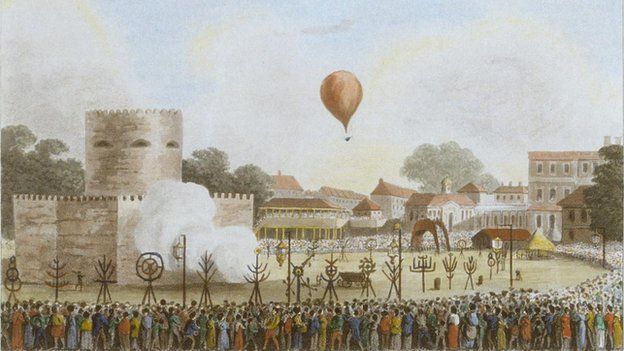James Sadler: The Man With His Head in the Clouds.

My new year's resolution is to review all the books I have accepted for review and not reviewed! Some are years overdue. While tidying up before Christmas I was mortified to discover my copy of Richard O. Smith's amusing novel The Man With His Head in the Clouds, which I promised him faithfully I would review. So here goes!
The Man With His Head in the Clouds is a book about James Sadler, the first Englishman to fly. Sadler, who lived in Oxford, was a pioneer of hot-air ballooning, and made his first, daring flights in the 1780s when few people even believed it could be done. He was among the very first aeronauts in human history, only one year behind the French Montgolfier brothers and Rozier. Sadler came from a humble background - his father kept a café in the centre of Oxford - he never went to university and he had no wealthy or royal backers. So Richard O. Smith is absolutely right that Sadler should be far more famous than he is. He even invented a moving steam engine, yet few people have ever heard of him.
Many early aeronauts were killed in the attempt. Sadler's skill is evinced by the fact that he made fifty flights in his long career, and died in 1828.
The book is not just about Sadler, and other members of his family who joined in his aviation exploits. It's also a rambling, self-indulgent autobiography that goes off on many a tangent and explores many byways. Richard O. Smith is determined to emulate his hero, Sadler, and his greatest ambition is to re-enact Sadler's historic first balloon flight over Oxford. This is complicated by the fact that Smith suffers from a fear of heights, which many people refer to as vertigo but which he explains is actually "acrophobia". People who are acrophobic are nervous enough at the top of a high staircase, and to attempt aviation would seem to be perverse. But Smith perserveres, using psychoanalysis and every other possible means to overcome his terror, until eventually, with the aid of Richard Branson, he does take part in a successful balloon flight across Oxford, replicating as closely as possible the exploit of Sadler.
This is all the more fascinating for me as I too suffer from fear of heights. I heartily share Smith's dislike of glass floors on upper storeys of buildings. I have climbed many a picturesque historic tower only to hurry down again feeling rather alarmed. I once froze rigid with terror on a Ferris wheel and I hate narrow bridges with gaps in the bottom where you get glimpses of the river or busy motorway far below your feet. Fear of heights is completely rational. It is a survival instinct that we have inherited from our remotest ancestors and it's just that some of us feel it more acutely than others. So I can sympathize with Mr Smith and I congratulate him on having learned, as he says, not to eradicate his fear, but to manage and control it.
You could if you are in a hurry just read the DNB entry on James Sadler and get most of the historical information about him in a short space of time. It's also true that there are other books about Sadler. And it's a pity that The Man With His Head in the Clouds is marred by the author writing "like" when he means "as if" and making rather silly recurrent jokes about the French. But if you are interested in the history of Oxford and are looking for an amusing book to while away some leisure time, you could do a lot worse than to read this.
